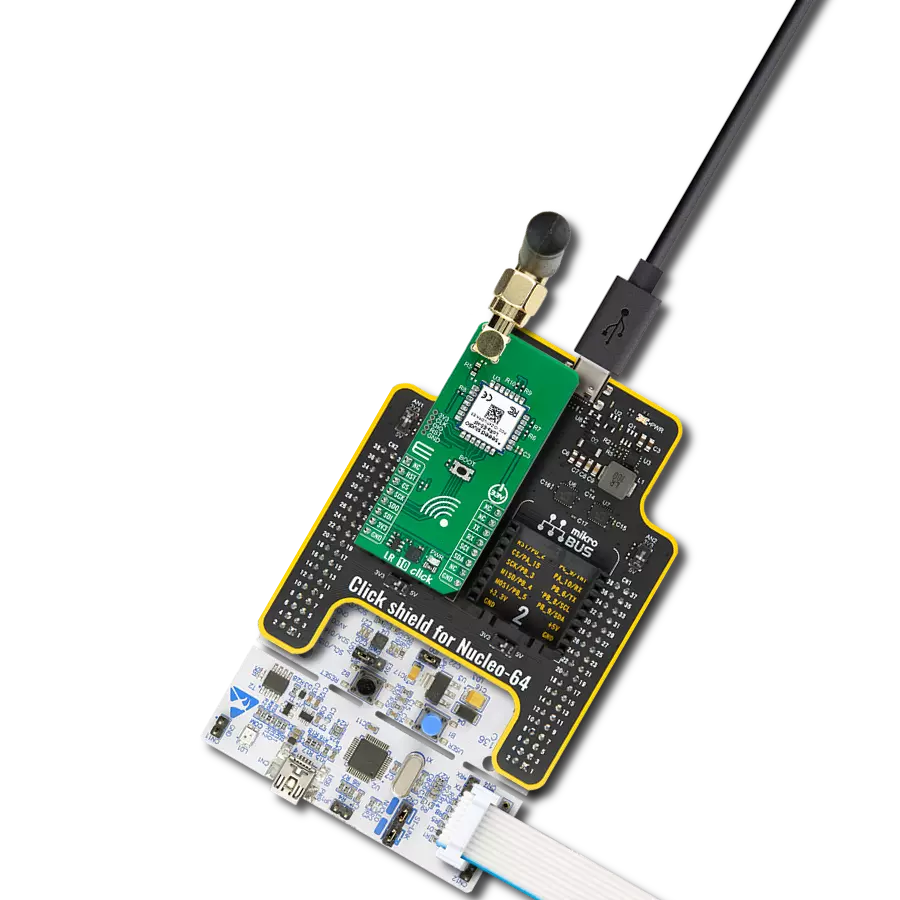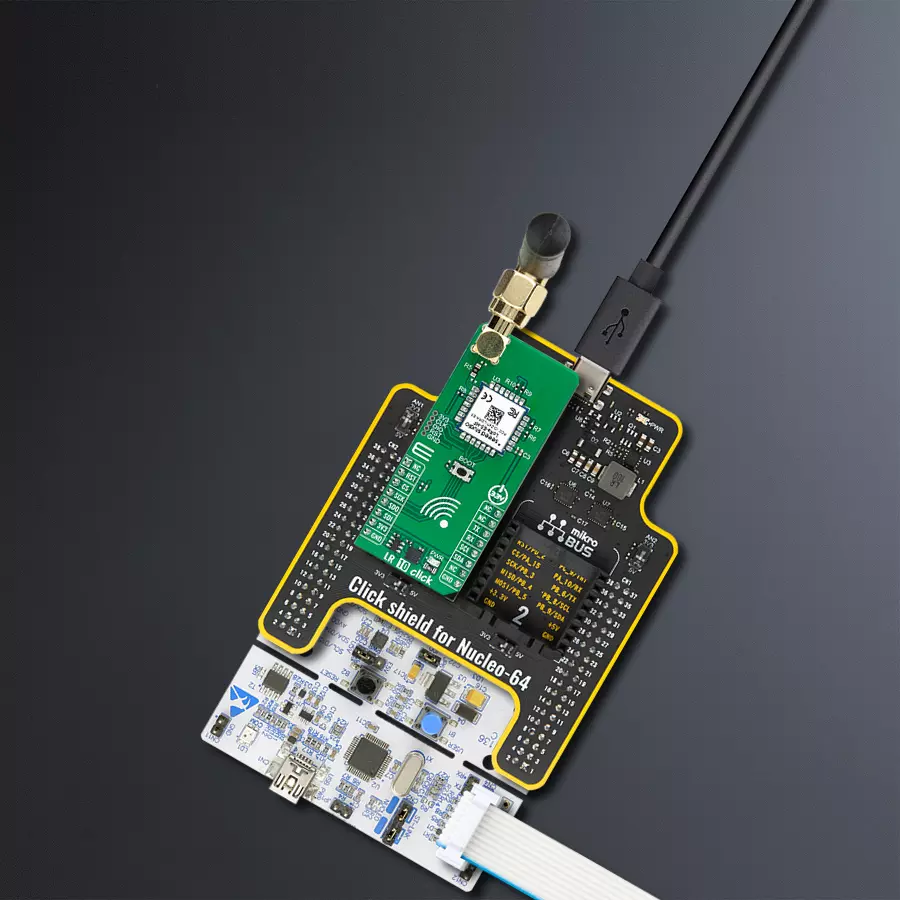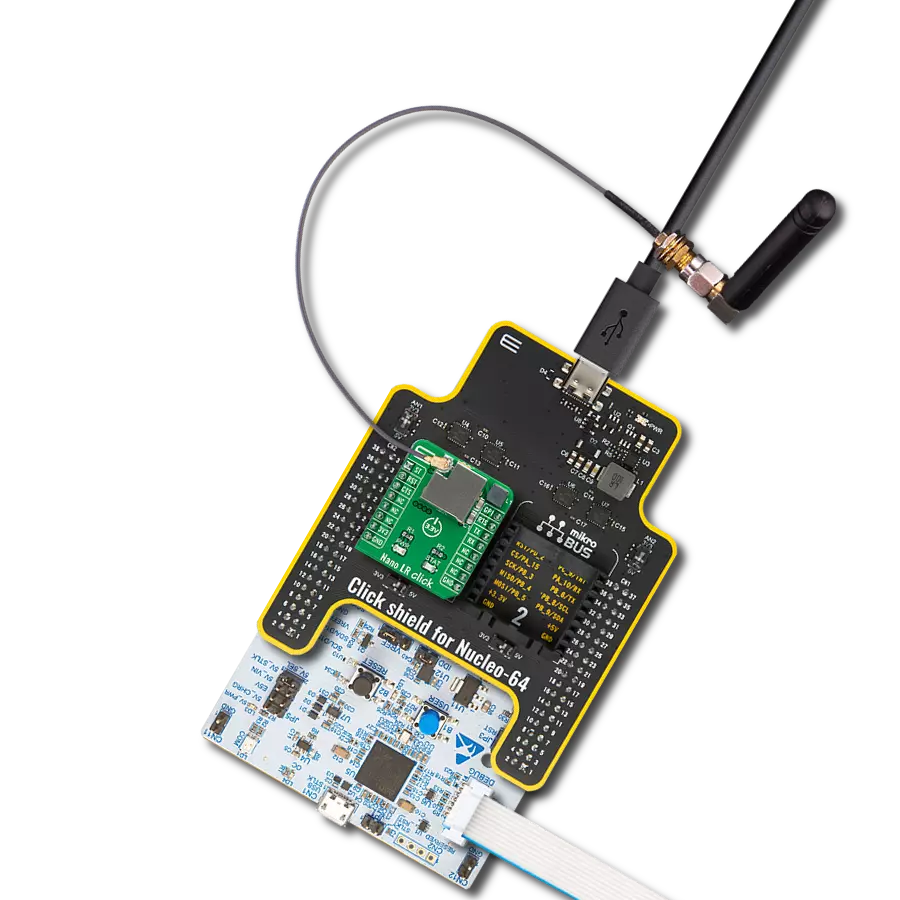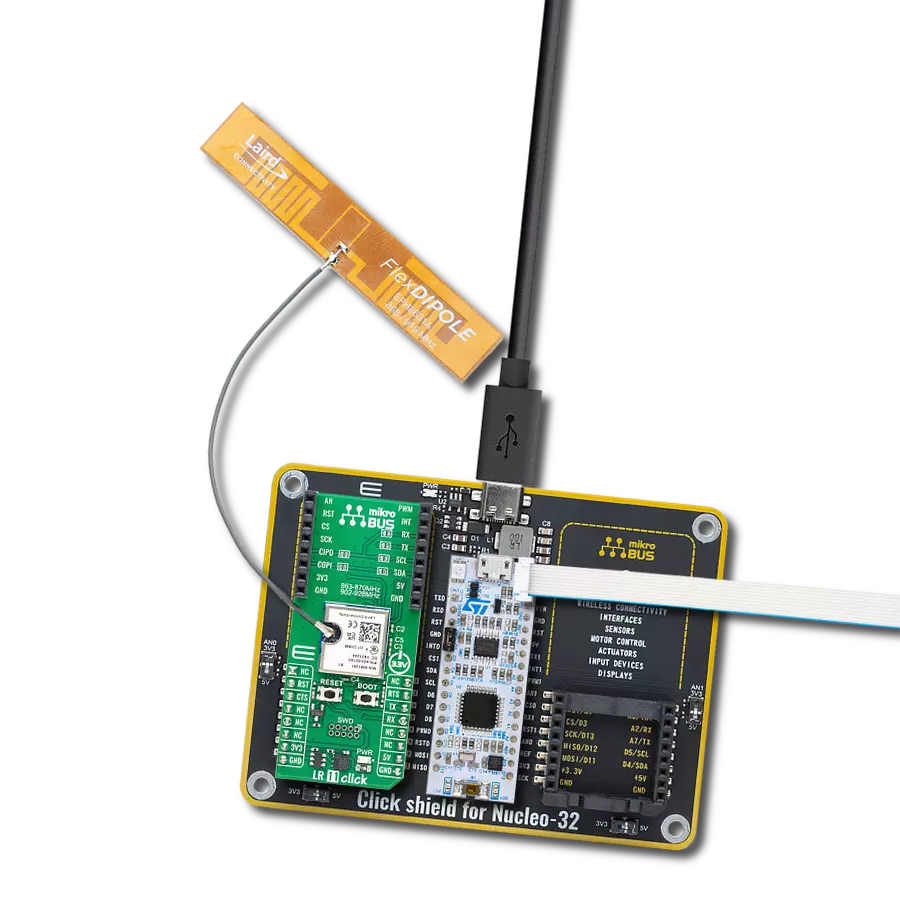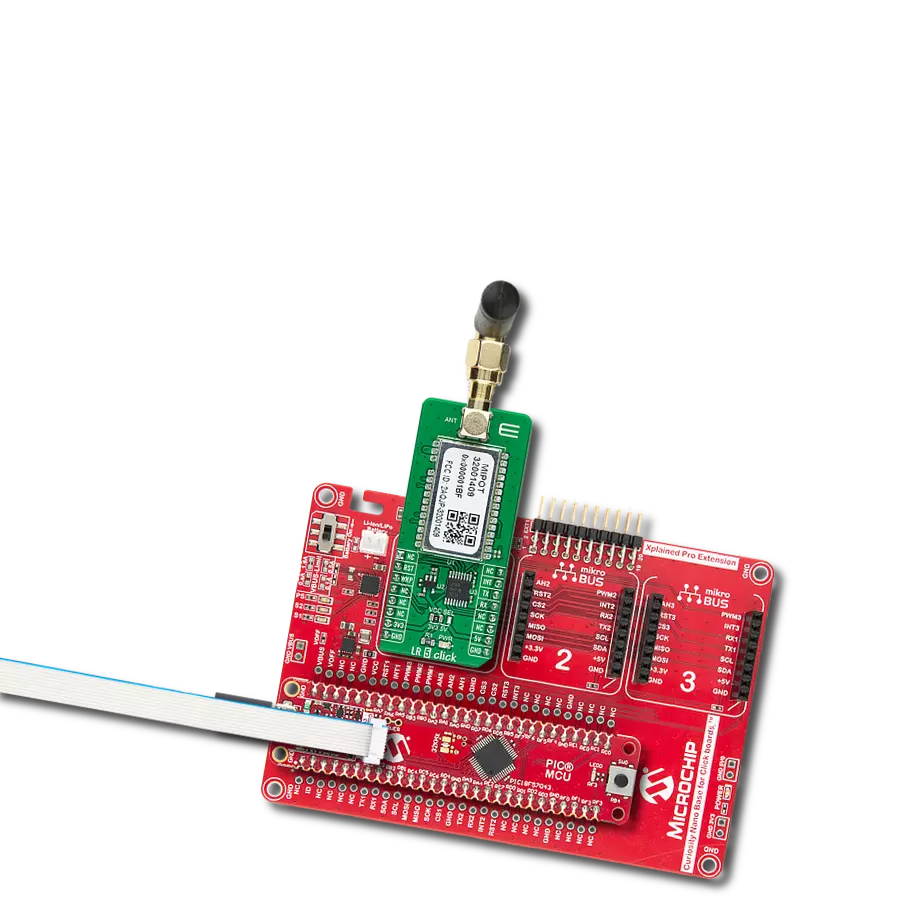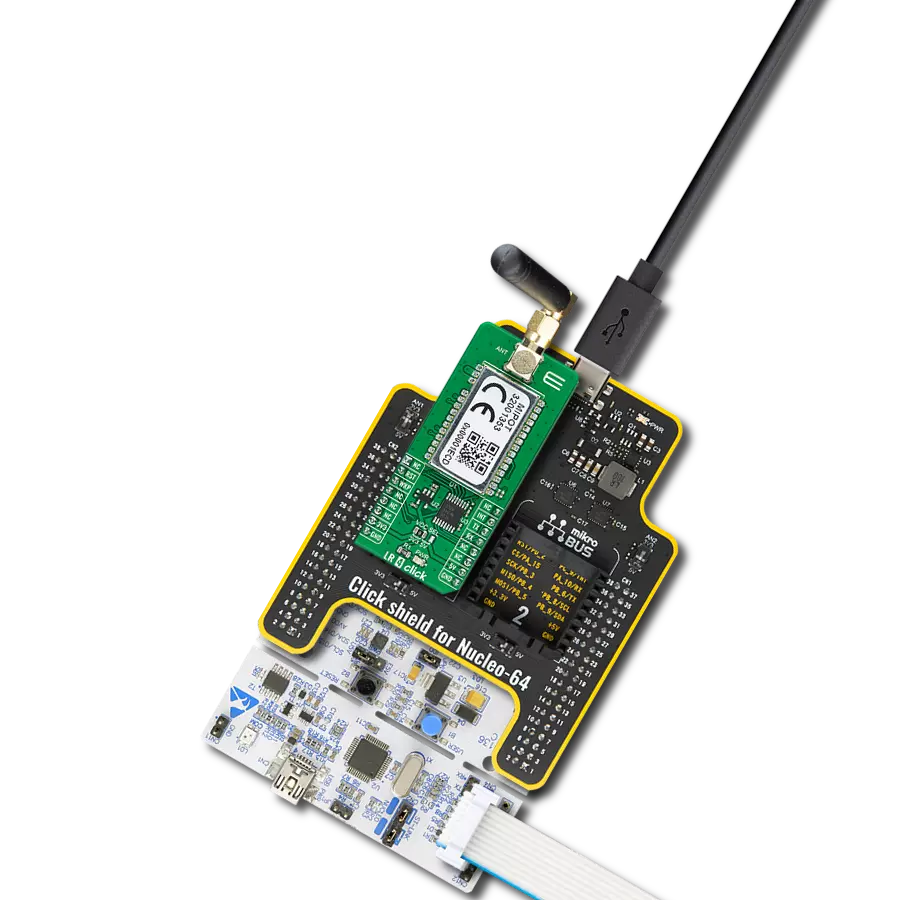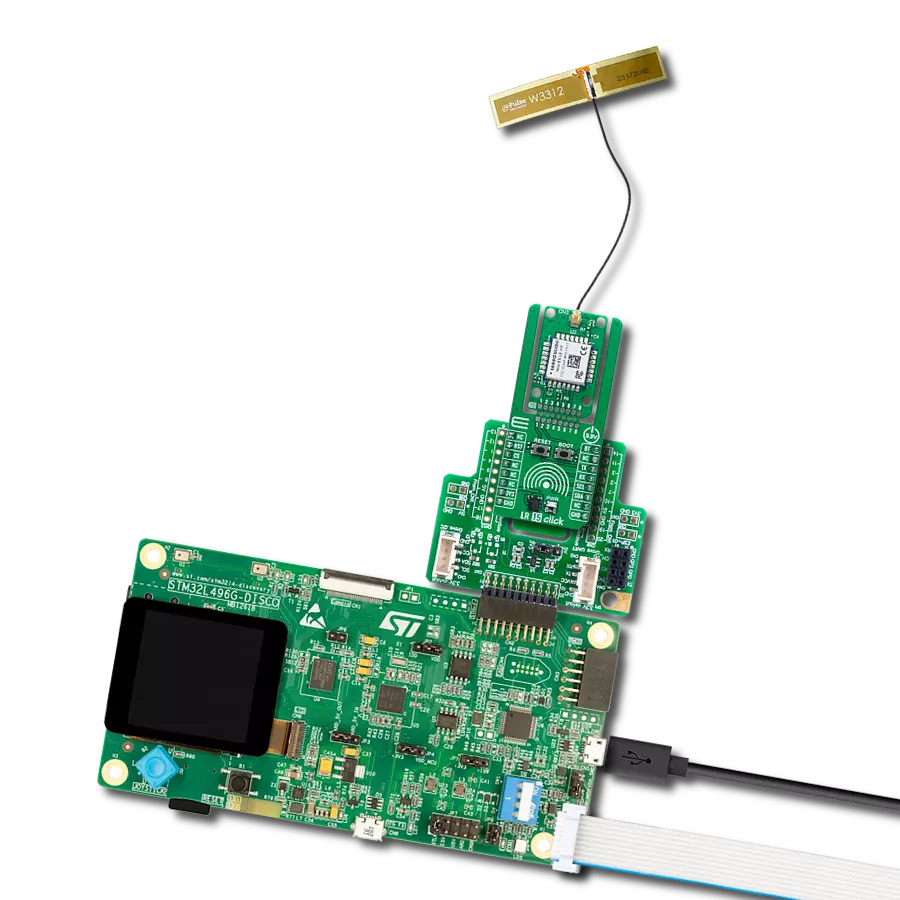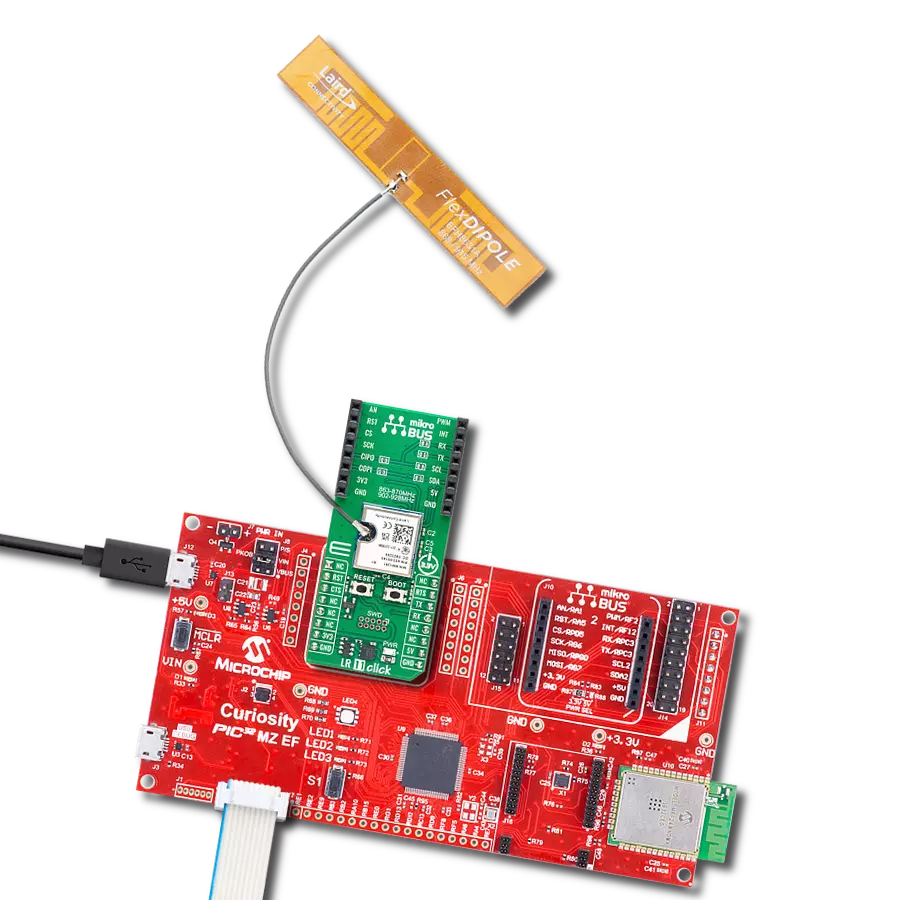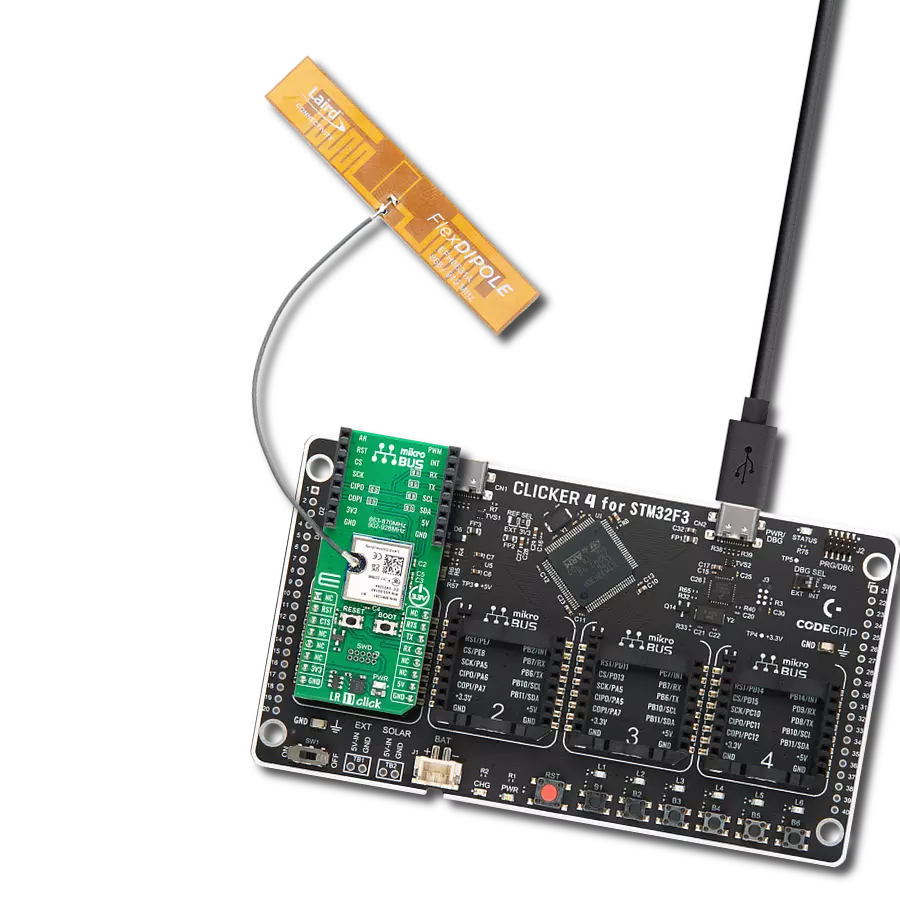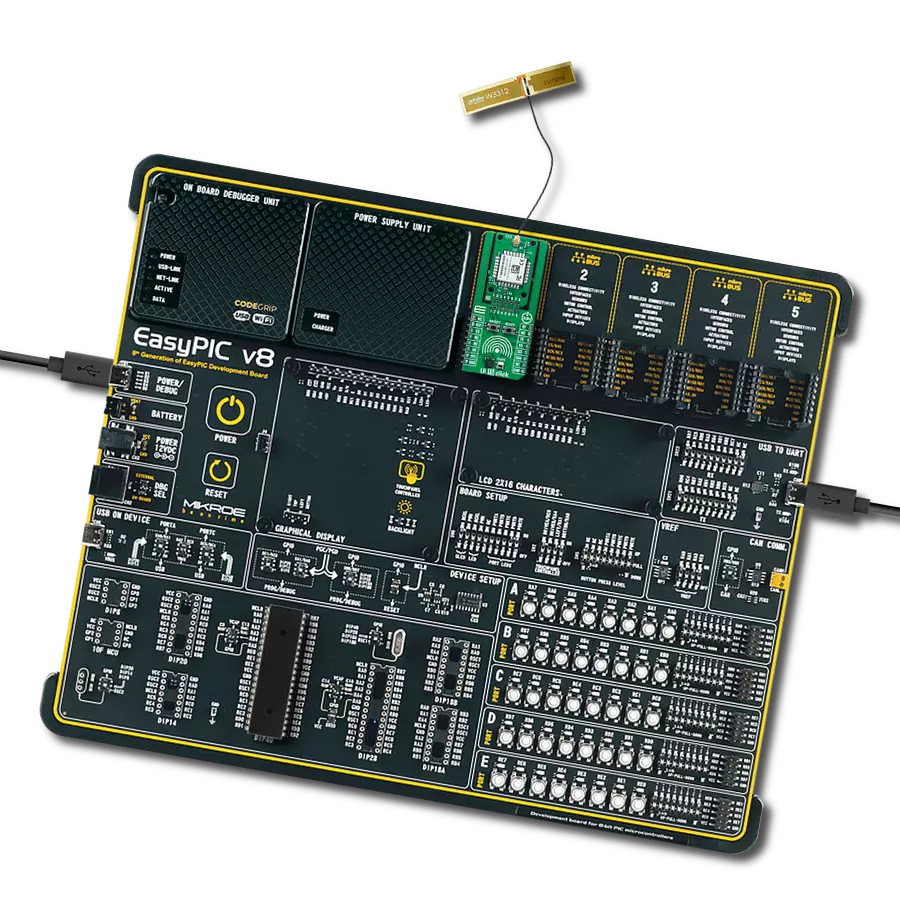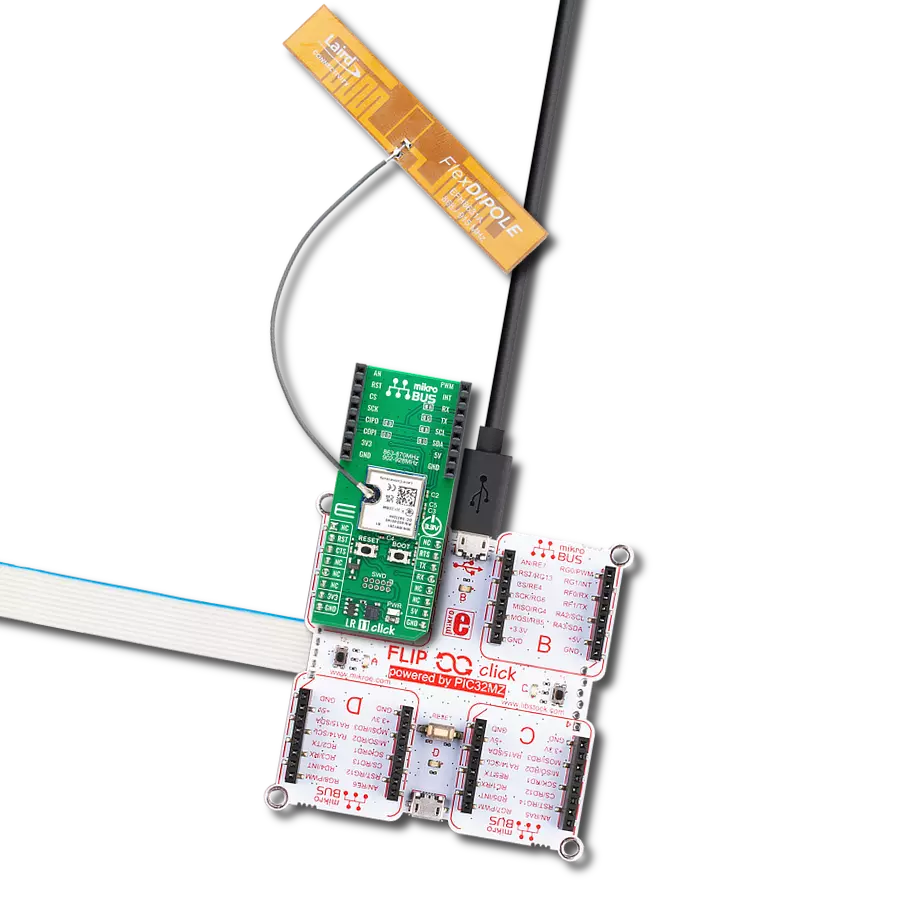Enhance Internet of Things (IoT) projects focusing on energy efficiency and extensive connectivity range
A
A
Hardware Overview
How does it work?
LR 10 Click is based on the Wio-E5, a LoRa wireless module from Seeed Technology, renowned for its minimal power draw and compactness. This powerhouse module incorporates the STM32WLE5JC system-level package chip and the SX126X LoRa® chip for stellar performance alongside an Arm® Cortex® M4 MCU that ensures ultra-low power consumption. Designed primarily for IoT applications requiring minimal power and extended range—such as wireless sensor networks, remote meter reading, and other low-power, wide-area network scenarios - the Wio-E5 stands out as a versatile solution for many IoT needs. As mentioned, the Wio-E5 module integrates the STM32WLE5JC. This chip excels in various IoT applications thanks to its support for multi-mode operations, including (G)FSK and LoRa®, with bandwidth options ranging from 62.5kHz to 500kHz in LoRa® mode. It is
characterized by a maximum RF input power of +10dBm, ensuring robust signal strength. The device operates seamlessly across a broad frequency range of 868 to 928MHz, accommodating a wide spectrum of wireless communication needs. With an ability to deliver an output power of up to 22dBm, it ensures extensive coverage and reliable transmission across its operational frequency range. Furthermore, the board achieves a peak sensitivity of -137.5dBm, guaranteeing consistent and dependable communication capabilities, even under demanding environmental conditions. This Click board offers a rich selection of available interfaces to communicate with the host MCU, such as UART, I2C, and SPI, catering to diverse application needs. It simplifies the design of LoRaWAN® nodes through embedded global LoRaWAN® protocol support and an AT command set achieved by UART
and reset RST pin integration. Firmware upgrades are also possible via the UART interface in a Boot mode, triggered by the BOOT button, allowing for easy programming and software development leveraging the onboard MCU's capabilities through the SWD interface pins on the board's side. LR 10 Click also features the SMA antenna connector with an impedance of 50Ω, compatible with various antennas available from MIKROE, like the Rubber Antenna 868MHz, to enhance its connectivity. This Click board™ can be operated only with a 3.3V logic voltage level. The board must perform appropriate logic voltage level conversion before using MCUs with different logic levels. Also, it comes equipped with a library containing functions and an example code that can be used as a reference for further development.
Features overview
Development board
Nucleo-64 with STM32F091RC MCU offers a cost-effective and adaptable platform for developers to explore new ideas and prototype their designs. This board harnesses the versatility of the STM32 microcontroller, enabling users to select the optimal balance of performance and power consumption for their projects. It accommodates the STM32 microcontroller in the LQFP64 package and includes essential components such as a user LED, which doubles as an ARDUINO® signal, alongside user and reset push-buttons, and a 32.768kHz crystal oscillator for precise timing operations. Designed with expansion and flexibility in mind, the Nucleo-64 board features an ARDUINO® Uno V3 expansion connector and ST morpho extension pin
headers, granting complete access to the STM32's I/Os for comprehensive project integration. Power supply options are adaptable, supporting ST-LINK USB VBUS or external power sources, ensuring adaptability in various development environments. The board also has an on-board ST-LINK debugger/programmer with USB re-enumeration capability, simplifying the programming and debugging process. Moreover, the board is designed to simplify advanced development with its external SMPS for efficient Vcore logic supply, support for USB Device full speed or USB SNK/UFP full speed, and built-in cryptographic features, enhancing both the power efficiency and security of projects. Additional connectivity is
provided through dedicated connectors for external SMPS experimentation, a USB connector for the ST-LINK, and a MIPI® debug connector, expanding the possibilities for hardware interfacing and experimentation. Developers will find extensive support through comprehensive free software libraries and examples, courtesy of the STM32Cube MCU Package. This, combined with compatibility with a wide array of Integrated Development Environments (IDEs), including IAR Embedded Workbench®, MDK-ARM, and STM32CubeIDE, ensures a smooth and efficient development experience, allowing users to fully leverage the capabilities of the Nucleo-64 board in their projects.
Microcontroller Overview
MCU Card / MCU
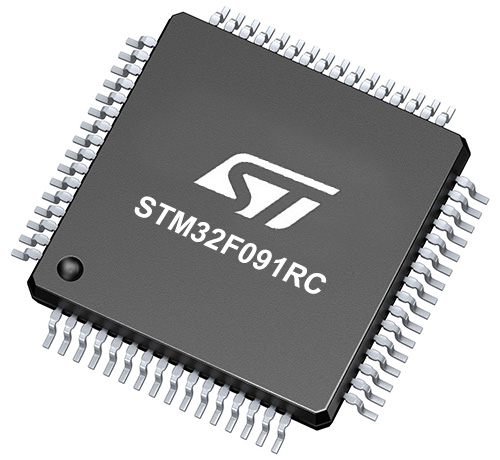
Architecture
ARM Cortex-M0
MCU Memory (KB)
256
Silicon Vendor
STMicroelectronics
Pin count
64
RAM (Bytes)
32768
You complete me!
Accessories
Click Shield for Nucleo-64 comes equipped with two proprietary mikroBUS™ sockets, allowing all the Click board™ devices to be interfaced with the STM32 Nucleo-64 board with no effort. This way, Mikroe allows its users to add any functionality from our ever-growing range of Click boards™, such as WiFi, GSM, GPS, Bluetooth, ZigBee, environmental sensors, LEDs, speech recognition, motor control, movement sensors, and many more. More than 1537 Click boards™, which can be stacked and integrated, are at your disposal. The STM32 Nucleo-64 boards are based on the microcontrollers in 64-pin packages, a 32-bit MCU with an ARM Cortex M4 processor operating at 84MHz, 512Kb Flash, and 96KB SRAM, divided into two regions where the top section represents the ST-Link/V2 debugger and programmer while the bottom section of the board is an actual development board. These boards are controlled and powered conveniently through a USB connection to program and efficiently debug the Nucleo-64 board out of the box, with an additional USB cable connected to the USB mini port on the board. Most of the STM32 microcontroller pins are brought to the IO pins on the left and right edge of the board, which are then connected to two existing mikroBUS™ sockets. This Click Shield also has several switches that perform functions such as selecting the logic levels of analog signals on mikroBUS™ sockets and selecting logic voltage levels of the mikroBUS™ sockets themselves. Besides, the user is offered the possibility of using any Click board™ with the help of existing bidirectional level-shifting voltage translators, regardless of whether the Click board™ operates at a 3.3V or 5V logic voltage level. Once you connect the STM32 Nucleo-64 board with our Click Shield for Nucleo-64, you can access hundreds of Click boards™, working with 3.3V or 5V logic voltage levels.
868MHz right-angle rubber antenna is a compact and versatile solution for wireless communication. Operating within the frequency range of 868-915MHz, it ensures optimal signal reception and transmission. With a 50-ohm impedance, it's compatible with various devices and systems. This antenna boasts a 2dB gain, enhancing signal strength and extending communication range. Its vertical polarization further contributes to signal clarity. Designed to handle up to 50W of input power, it's a robust choice for various applications. Measuring just 48mm in length, this antenna is both discreet and practical. Its SMA male connector ensures a secure and reliable connection to your equipment. Whether you're working with IoT devices, remote sensors, or other wireless technologies, the 868MHz right-angle antenna offers the performance and flexibility you need for seamless communication.
Used MCU Pins
mikroBUS™ mapper
Take a closer look
Click board™ Schematic
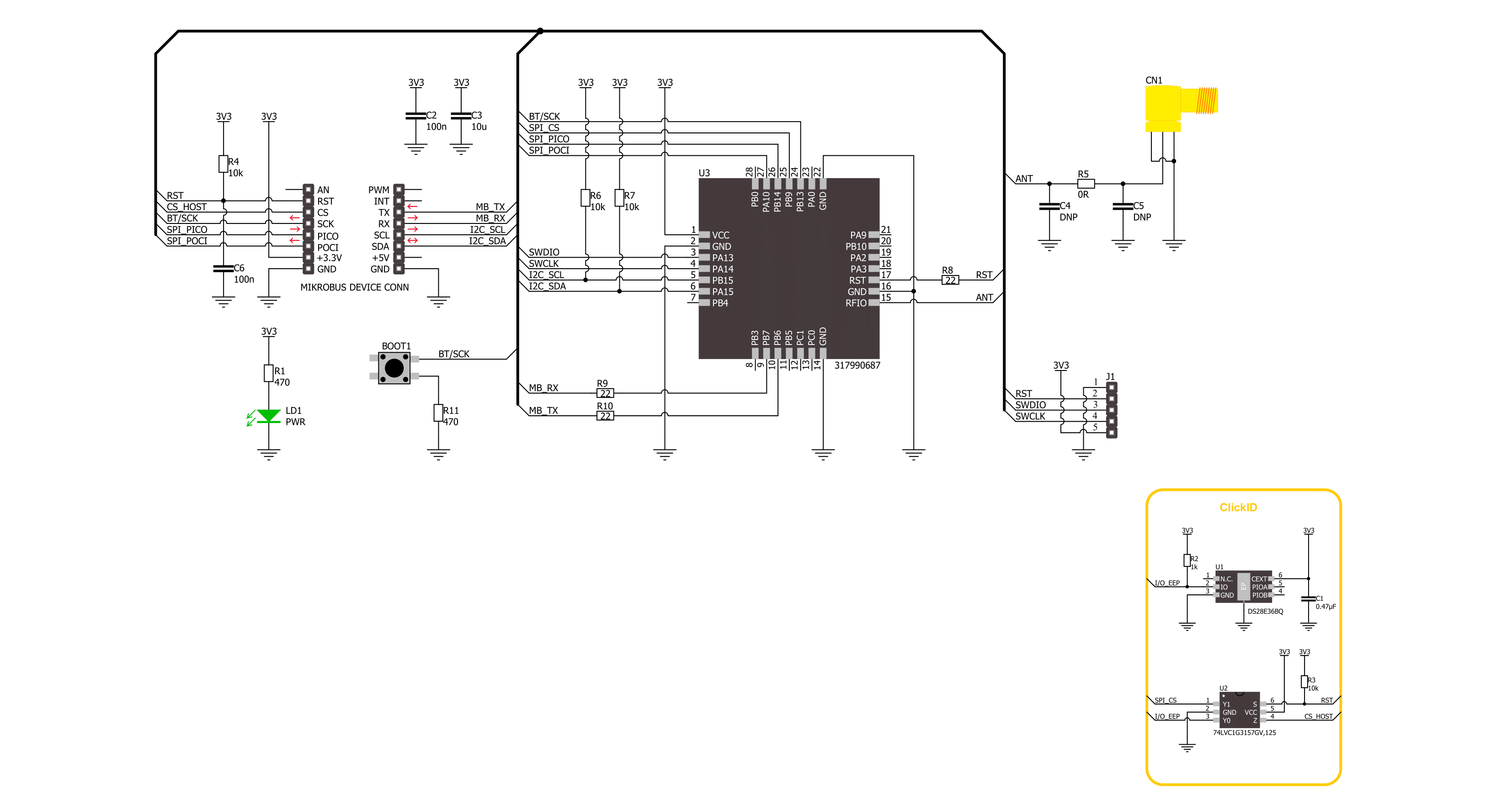
Step by step
Project assembly
Track your results in real time
Application Output
1. Application Output - In Debug mode, the 'Application Output' window enables real-time data monitoring, offering direct insight into execution results. Ensure proper data display by configuring the environment correctly using the provided tutorial.

2. UART Terminal - Use the UART Terminal to monitor data transmission via a USB to UART converter, allowing direct communication between the Click board™ and your development system. Configure the baud rate and other serial settings according to your project's requirements to ensure proper functionality. For step-by-step setup instructions, refer to the provided tutorial.

3. Plot Output - The Plot feature offers a powerful way to visualize real-time sensor data, enabling trend analysis, debugging, and comparison of multiple data points. To set it up correctly, follow the provided tutorial, which includes a step-by-step example of using the Plot feature to display Click board™ readings. To use the Plot feature in your code, use the function: plot(*insert_graph_name*, variable_name);. This is a general format, and it is up to the user to replace 'insert_graph_name' with the actual graph name and 'variable_name' with the parameter to be displayed.

Software Support
Library Description
This library contains API for LR 10 Click driver.
Key functions:
lr10_write_cmd- This function writes a desired command by using UART serial interfacelr10_write_cmd_sub_param- This function writes a desired command, subcommands and parameter by using UART serial interface
Open Source
Code example
The complete application code and a ready-to-use project are available through the NECTO Studio Package Manager for direct installation in the NECTO Studio. The application code can also be found on the MIKROE GitHub account.
/*!
* @file main.c
* @brief LR 10 Click Example.
*
* # Description
* This example demonstrates the use of LR 10 Click board by processing
* the incoming data and displaying them on the USB UART.
*
* The demo application is composed of two sections :
*
* ## Application Init
* Initializes the driver and performs a hardware reset of the device.
*
* ## Application Task
* Depending on the selected mode, the application demo
* receives and processes all incoming data or sends the LoRa packet demo string.
* Results are being sent to the UART Terminal, where you can track their changes.
*
* ## Additional Function
* - static void lr10_clear_app_buf ( void )
* - static void lr10_log_app_buf ( void )
* - static void lr10_log_receiver ( void )
* - static err_t lr10_process ( lr10_t *ctx )
*
* @author Nenad Filipovic
*
*/
#include "board.h"
#include "log.h"
#include "lr10.h"
#include "conversions.h"
// Comment the line below to switch application mode to receiver
#define DEMO_APP_TRANSMITTER
// Application buffer size
#define PROCESS_BUFFER_SIZE 200
// Default RF configuration
#define PROCESS_RF_CFG_DEFAULT "868,SF7,125,8,8,14,ON,OFF,OFF"
// Application demo string
#define LR10_DEMO_STRING "MikroE - LR 10 Click"
static lr10_t lr10;
static log_t logger;
static uint8_t app_buf[ PROCESS_BUFFER_SIZE ] = { 0 };
static int32_t app_buf_len = 0;
/**
* @brief LR 10 clearing application buffer.
* @details This function clears memory of application buffer and reset its length.
* @note None.
*/
static void lr10_clear_app_buf ( void );
/**
* @brief LR 10 log application buffer.
* @details This function logs data from application buffer to USB UART.
* @note None.
*/
static void lr10_log_app_buf ( void );
/**
* @brief LR 10 log receiver data.
* @details This function logs data from receiver application buffer to USB UART.
* @note None.
*/
static void lr10_log_receiver ( void );
/**
* @brief LR 10 data reading function.
* @details This function reads data from device and concatenates data to application buffer.
* @param[in] ctx : Click context object.
* See #lr10_t object definition for detailed explanation.
* @return @li @c 0 - Read some data.
* @li @c -1 - Nothing is read.
* See #err_t definition for detailed explanation.
* @note None.
*/
static err_t lr10_process ( lr10_t *ctx );
void application_init ( void )
{
log_cfg_t log_cfg; /**< Logger config object. */
lr10_cfg_t lr10_cfg; /**< Click config object. */
/**
* Logger initialization.
* Default baud rate: 115200
* Default log level: LOG_LEVEL_DEBUG
* @note If USB_UART_RX and USB_UART_TX
* are defined as HAL_PIN_NC, you will
* need to define them manually for log to work.
* See @b LOG_MAP_USB_UART macro definition for detailed explanation.
*/
LOG_MAP_USB_UART( log_cfg );
log_init( &logger, &log_cfg );
log_info( &logger, " Application Init " );
// Click initialization.
lr10_cfg_setup( &lr10_cfg );
LR10_MAP_MIKROBUS( lr10_cfg, MIKROBUS_1 );
if ( UART_ERROR == lr10_init( &lr10, &lr10_cfg ) )
{
log_error( &logger, " Communication init." );
for ( ; ; );
}
lr10_hw_reset( &lr10 );
Delay_ms ( 500 );
lr10_generic_write( &lr10, LR10_CMD_AT, strlen(LR10_CMD_AT) );
if ( LR10_OK == lr10_process( &lr10 ) )
{
lr10_log_app_buf( );
lr10_clear_app_buf( );
}
Delay_ms ( 500 );
lr10_write_cmd( &lr10, LR10_CMD_VER );
if ( LR10_OK == lr10_process( &lr10 ) )
{
lr10_log_app_buf( );
lr10_clear_app_buf( );
}
Delay_ms ( 500 );
lr10_write_cmd( &lr10, LR10_CMD_ID );
if ( LR10_OK == lr10_process( &lr10 ) )
{
lr10_log_app_buf( );
lr10_clear_app_buf( );
}
Delay_ms ( 500 );
lr10_write_cmd_sub_param( &lr10, LR10_CMD_MODE, LR10_SUB_CMD_MODE_TEST,
LR10_SYMBOL_NULL, LR10_QUOTE_DISABLE );
if ( LR10_OK == lr10_process( &lr10 ) )
{
lr10_log_app_buf( );
lr10_clear_app_buf( );
}
Delay_ms ( 500 );
lr10_write_cmd( &lr10, LR10_CMD_TEST );
if ( LR10_OK == lr10_process( &lr10 ) )
{
lr10_log_app_buf( );
lr10_clear_app_buf( );
}
Delay_ms ( 500 );
lr10_inquire_cmd( &lr10, LR10_CMD_MODE );
if ( LR10_OK == lr10_process( &lr10 ) )
{
lr10_log_app_buf( );
lr10_clear_app_buf( );
}
Delay_ms ( 500 );
#ifdef DEMO_APP_TRANSMITTER
lr10_write_cmd_sub_param( &lr10, LR10_CMD_TEST, LR10_SUB_CMD_TEST_RFCFG,
PROCESS_RF_CFG_DEFAULT, LR10_QUOTE_DISABLE );
if ( LR10_OK == lr10_process( &lr10 ) )
{
lr10_log_app_buf( );
lr10_clear_app_buf( );
}
Delay_ms ( 500 );
#endif
}
void application_task ( void )
{
#ifdef DEMO_APP_TRANSMITTER
lr10_write_cmd_sub_param( &lr10, LR10_CMD_TEST, LR10_SUB_CMD_TEST_TX_STR,
LR10_DEMO_STRING, LR10_QUOTE_ENABLE );
if ( LR10_OK == lr10_process( &lr10 ) )
{
lr10_log_app_buf( );
lr10_clear_app_buf( );
}
#else
lr10_write_cmd_param( &lr10, LR10_CMD_TEST, LR10_SUB_CMD_TEST_RX );
if ( LR10_OK == lr10_process( &lr10 ) )
{
lr10_log_receiver( );
lr10_clear_app_buf( );
}
#endif
Delay_ms ( 1000 );
}
int main ( void )
{
/* Do not remove this line or clock might not be set correctly. */
#ifdef PREINIT_SUPPORTED
preinit();
#endif
application_init( );
for ( ; ; )
{
application_task( );
}
return 0;
}
static void lr10_clear_app_buf ( void )
{
memset( app_buf, 0, app_buf_len );
app_buf_len = 0;
}
static void lr10_log_app_buf ( void )
{
for ( int32_t buf_cnt = 0; buf_cnt < app_buf_len; buf_cnt++ )
{
log_printf( &logger, "%c", app_buf[ buf_cnt ] );
}
}
static void lr10_log_receiver ( void )
{
for ( int32_t buf_cnt = 0; buf_cnt < app_buf_len; buf_cnt++ )
{
if ( ( app_buf[ buf_cnt ] == LR10_ASCII_SPACE ) &&
( app_buf[ buf_cnt + 1 ] == LR10_ASCII_QUOTE ) )
{
buf_cnt += 2;
log_printf( &logger, " Receive: " );
for ( ; buf_cnt < app_buf_len - 3; buf_cnt += 2 )
{
uint8_t hex_in[ 3 ] = { 0 };
hex_in[ 0 ] = app_buf[ buf_cnt ];
hex_in[ 1 ] = app_buf[ buf_cnt + 1 ];
log_printf( &logger, "%c", hex_to_uint8( hex_in ) );
}
log_printf( &logger, "\r\n" );
break;
}
}
}
static err_t lr10_process ( lr10_t *ctx )
{
uint8_t rx_buf[ PROCESS_BUFFER_SIZE ] = { 0 };
int32_t overflow_bytes = 0;
int32_t rx_cnt = 0;
int32_t rx_size = lr10_generic_read( ctx, rx_buf, PROCESS_BUFFER_SIZE );
if ( ( rx_size > 0 ) && ( rx_size <= PROCESS_BUFFER_SIZE ) )
{
if ( ( app_buf_len + rx_size ) > PROCESS_BUFFER_SIZE )
{
overflow_bytes = ( app_buf_len + rx_size ) - PROCESS_BUFFER_SIZE;
app_buf_len = PROCESS_BUFFER_SIZE - rx_size;
memmove ( app_buf, &app_buf[ overflow_bytes ], app_buf_len );
memset ( &app_buf[ app_buf_len ], 0, overflow_bytes );
}
for ( rx_cnt = 0; rx_cnt < rx_size; rx_cnt++ )
{
if ( rx_buf[ rx_cnt ] )
{
app_buf[ app_buf_len++ ] = rx_buf[ rx_cnt ];
}
}
return LR10_OK;
}
return LR10_ERROR;
}
// ------------------------------------------------------------------------ END
Additional Support
Resources
Category:LoRa
